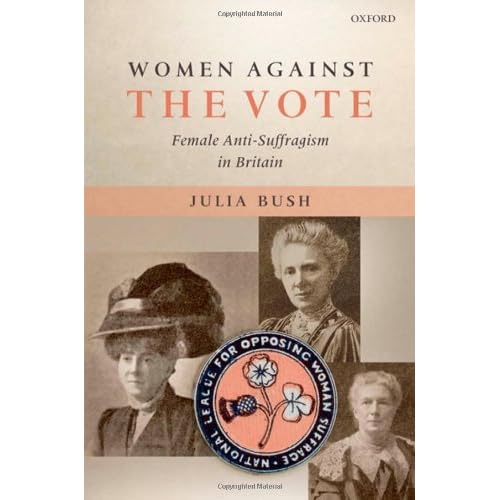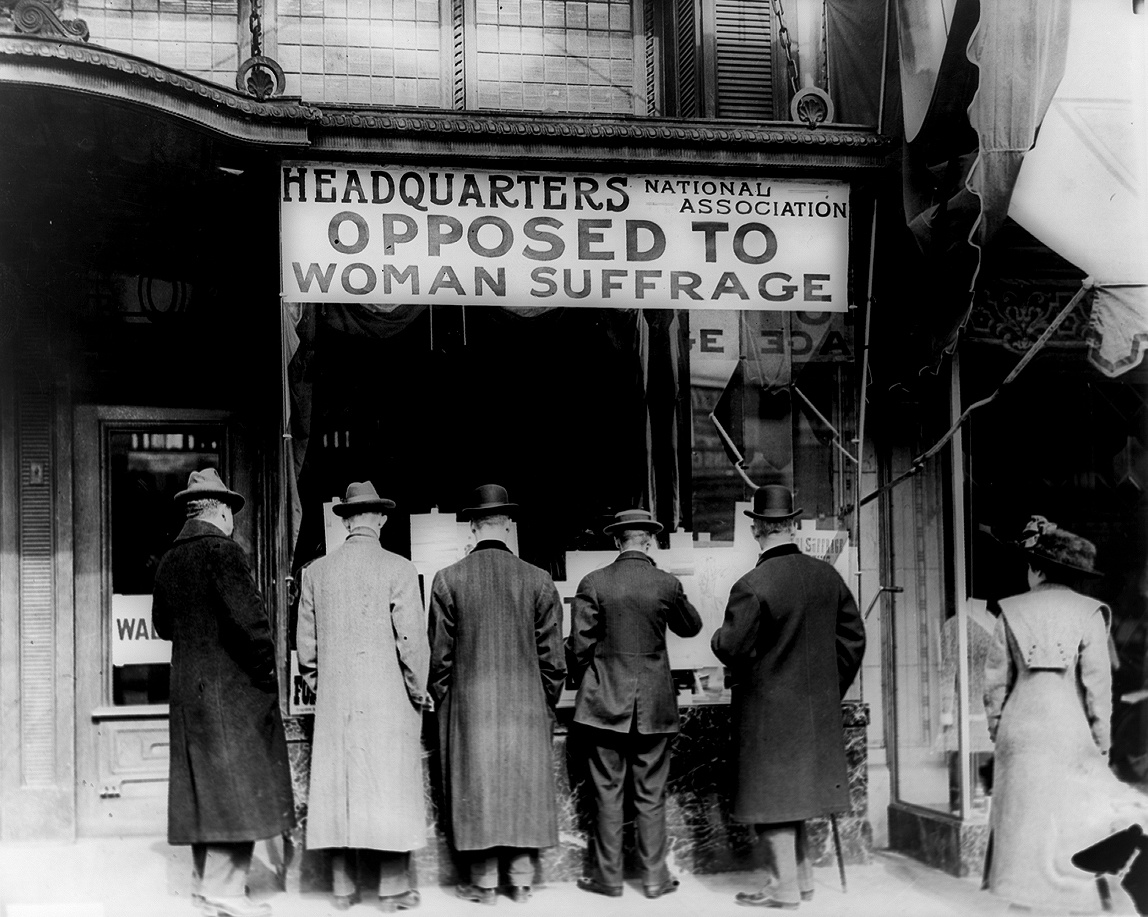Yet many intelligent women thought deeply about universal suffrage and opposed it vigorously. Julia Bush showed how a British anti-suffrage campaign had taken place in The Times newspaper in 1906 and 1907. Soon a letter was circulated to announce the creation of a National Women's Anti-Suffrage Association and inviting recipients to become a member of the central organising committee or a member. Thus the Women's National Anti-Suffrage League was established in London in July 1908. Its aims were to oppose women voting in parliamentary elections, although it did support their having votes in local government elections. It was particularly noted that at least 30 women from noble families identified themselves as active anti-suffragists, as well as a number of peers and MPs.
The first meeting of the Women's National Anti-Suffrage League was held in July 1908 with Margaret Countess of Jersey in the Chair. 17 persons were nominated to the central committee at this meeting, including novelist Mrs Humphrey (Mary) Ward in the chair of the Literary Committee and writer-traveller Gertrude Bell as secretary. Other members were Violet Markham and Hilaire Belloc MP.
Women Against The Vote, written by Julia Bush (2007)
The League's aims were to oppose women being granted the parliamentary franchise, though it did support their having votes in local and municipal elections. They encouraged women to spend their energy and talents on the big moral issues of the day: philanthropy, local government, childcare, health, education, housing and moral welfare, not politics. Looking At History believed the rhetoric that informed both anti- and pro-suffragist political argument was in some ways very similar. Mary Ward’s view of differentiated citizenship celebrated the distinctive roles of men and women in society, while suffragists emphasised what men and women had in common. So the League members had no trouble in cooperating closely with suffragettes on non-political causes, causes that concerned all female activists.
Branches were opened in Kent in 1908 then in London. In May 1910, a Scottish branch was organised into the Scottish National Anti-Suffrage League by the Duchess of Montrose. By July 1910, there were 104 branches with up to 50,000 members.
In 1910, the Women's National Anti-Suffrage League made a very bad decision. This very large group amalgamated with the very small Men's National League for Opposing Women's Franchise to form the National League for Opposing Women's Suffrage, with Evelyn Baring 1st Earl of Cromer as president and Countess Margaret of Jersey as Vice-President. The women and men shared their anti-suffrage position, but disagreed on every other thing. The women wanted British women to be stronger, more involved in female-inspired reform programmes and to practise motherly social work. Lord Cromer and the men loathed vocal women; they felt that any major departure from women's role as wives and mothers would bring social chaos to Britain and destroy the Empire.
The former viceroy of India, George Curzon 1st Marquess Curzon of Kedleston, became president in 1912. Although the organisation managed to mount some sort of campaign up to the war under Lord Curzon, it became increasingly difficult for the large number of positive women to work with the small number of misogynist men.
In the end, two factors caused the organisation to end its work. Firstly by 1914 the anti-suffrage women turned to focus on the war; they were keen to demonstrate their superior patriotism, and to pursue their gender beliefs in the new wartime debates over such issues as female employment, maternity and childcare. The organisation’s activities and publications continued for the four war years, but by 1916, the anti-suffrage cause was seriously weakened and it became clear that franchise reform was inevitable. Secondly by 1918, when the first women's suffrage was granted (to those aged 30 or older), the movement was looking out-of-date and truly redundant.
Bloggers might like to read: Julia Bush, Women against the Vote: Female Anti-Suffragism in Britain, Oxford, 2007
National Association Opposed to Woman Suffrage, USA, 1912-8
I have included this American photo to indicate that apart from New Zealand (1893), Australia, Finland, Norway and Denmark, there was organised opposition to universal suffrage in almost every country in the world.
In 1911 several states in the USA's anti-suffrage associations merged, creating the National Association Opposed to Woman Suffrage, headquartered in New York City. The association recruited supporters "by educating the public in the belief that women can be more useful to the community without the ballot than if affiliated with and influenced by party politics." The organisation, consisting of state association representatives, sent speakers, funds and literature to campaigning states during the 1912-1918 period. By 1916 the NAOWS coordinated the activities of twenty-five state organisations. In 1918 they moved their headquarters to Washington DC where it operated until the passage of the 19th Amendment in 1920.













.jpg)




.webp)















.jpg)
















13 comments:
Hello Hels:
Even allowing for the very different social climate of the period, this all seems so absolutely incredible that women of the day should have actively opposed women's suffrage. And to have been led in this by women who, one would consider, had had the advantages of having been well educated, or at least have moved in educated circles, makes it all the more extraordinary.
Jane and Lance
The case against the vote was advanced through intense journalistic and literary debate over gender roles during the 1890s and early 1900s, fuelled both by the increasing prominence of the ‘new woman’ in fact and fiction and by social evolutionist concerns over Britain's imperial future (Oxford Dictionary National Biography).
Apart from the educated women we already mentioned, consider Ethel Bertha Harrison (writer, reformer); Elizabeth Burgwin (first woman member of the National Union of Teachers' executive); Beatrice Chamberlain (social worker and tariff reformer); Lady Haversham; Mrs Clarendon Hyde (wife of Liberal MP) etc etc. These were smart women!
Very cool blog. Interesting posts. ;)
Nice atmosphere guests with you here on the blog. ;]
Yours. Have a nice day. !
Follow me on facebook fanpage and blog
I'm very concerned about this, please. :)
https://www.facebook.com/pages/In-another-light/413836138693856
Very comfortable, educated and middle class women. Perhaps they had something to lose if their female house staff could vote. If the simple question, should women have a say in how society works by being able to cast a vote for parliamentary representation, be asked, how could anyone not agree.
Patrycja
thank you. Are you working on photographs from the suffragette era? Email me for a couple of really excellent references.
Andrew
I am so torn by exactly that dilemma. On one hand the literary and noble women who opposed the vote did so for well thought out, positive reasons eg so that women could concentrate on charity, education reforms and temperance.
On the other hand, those very women were already leading interesting and comfortable lives. So why would they join up with political nasties who wanted to keep women, drunks and imbeciles in the stone age?
New Zealand and Australia did very well regarding universal suffrage. No women martyring themselves and no women thrown in prison and tortured. Our men (and women) were amazing.
Deb
Participation in politics in New Zealand and Australia had originally been seen as a solely male responsibility; women were bound by the laws of the land, but without the vote, couldn't influence them.
Although universal suffrage DID have opponents in both New Zealand and Australia, I suspect the young, New World colonies wanted to show their modernity, equality and independence from Britain.
Hello Hels, I think that this is a good example of looking at history with modern eyes, and failing to understand situations that counter our own knowledge, attitudes and situation.
I think that women back then saw the complexities of suffrage, that it would change the status quo and also exact known and unknown penalties in exchange for the new privileges. Also, some women raised in that system might genuinely have believed (you can substitute 'were brainwashed') that women really were unprepared for or undeserving of the vote.
We don't really have to go so far back in history to find this attitude--look how many women opposed the ERA (Equal Rights Amendment) in America.
--Road to Parnassus
Parnassus
Historians always have to be wary of putting their own values onto the history of a different time and a different nation *agreed*.
But some facts are indisputable. Many male politicians, clergy and police were calling the reformers fat, ugly, neglectful mothers, marriage wreckers and anti-Christian. Activists were being gaoled and force fed via tubes down their nostrils. It must have been a nightmare.
There were many valuable causes on which the supporters and opponents of universal suffrage could get together, and did. So to see women harming other women was a terrible shame, I believe.
Examine the blog called Woman And Her Sphere, then go to the section called Suffrage Stories.
This is an excellent example of how relevant history can be in present day politics. I am sure many Suffragettes were thinking "don't tell me what I'll do with my vote and whether or not it will sway me from my principles" just like women last year were crying "don't tell me what to do with my body.
I loved this line: it became increasingly difficult for the large number of positive women to work with the small number of misogynist men.
Emm,
Single men in particular were annoyed by the thought that married men would be voting twice i.e that married women would automatically give the empty ballot paper to their husbands. Sheesh!
Post a Comment